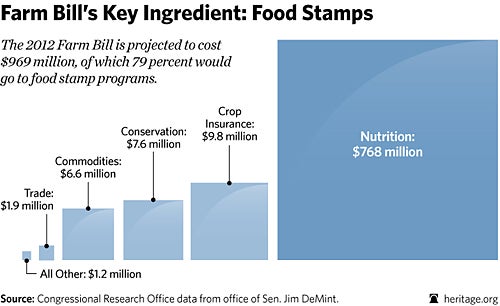The farm bill pending in the Senate has a bumper crop of food stamps. The bill, S.3240 (the Agriculture Reform, Food, and Jobs Act), should be renamed the “Food Stamp Expansion Act.” The bulk of the spending in the bill is targeted to the Supplemental Nutrition Assistance Program (SNAP), also commonly referred to as the food stamp program.
According to Senator Jeff Sessions (R–AL), “when food stamps were first expanded nationally in the 1970s, just one in 50 Americans participated; today the figure is almost one in 7.” Obamanomics can’t be blamed for the estimated doubling in the size of the program since 2008. Instead, the culprits are an expansion of eligibility requirements by the states and a lack of action by the federal government to condition federal food stamp monies on reform.
Senator Sessions made a compelling case yesterday that the farm bill needs to be reformed.
One problem with the program is that individuals receive benefits without any effective means testing. Senator Sessions has an amendment that would restore the asset test for food stamps to save $11 billion over the next 10 years. According to Sessions, “through a system known as categorical eligibility, 43 states provide benefits to individuals whose assets exceed the statutory asset limit. (Only 11 states did so in 2007.)” This provision would make sure people are not getting food stamps who don’t need them.
According to Heritage’s Rachel Sheffield, there has been a massive spike in food stamp participation since 2000 that costs the taxpayers billions. Sheffield argues that “since 2000, the number of Americans on food stamps has jumped by roughly 260 percent, to 44.7 million in 2011. During that same period, government spending on food stamps nearly quadrupled, to $78 billion last year.” One reason why is that billions have been doled out to ineligible recipients.
Food stamp spending has doubled under the Obama Administration, yet this bill does nothing to end the trajectory of the program. The pending farm bill spends an estimated $82 billion on food stamps in 2013. That figure dwarfs the numbers for other programs in the so-called farm bill. This bill is less about helping farmers and more about expanding a welfare program that is in dire need of reform.































